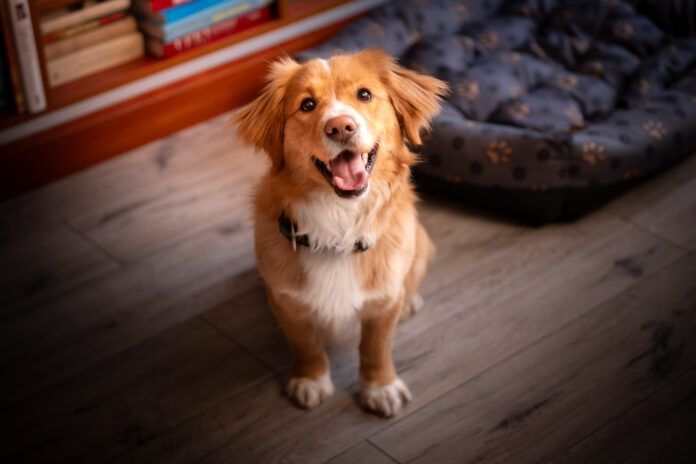Top Couch Covers for Dogs
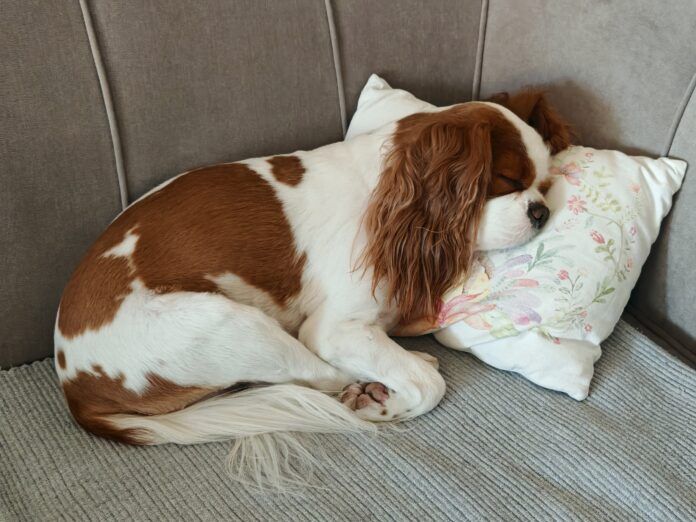
Practical Dog Clothes
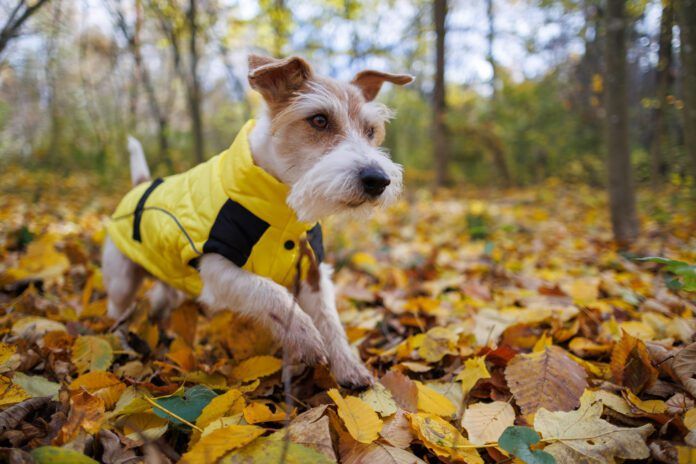
Join Whole Dog Journal
Already a member?
Click Here to Sign In | Forgot your password? | Activate Web AccessIs That Ringworm or a Hot Spot on My Dog?
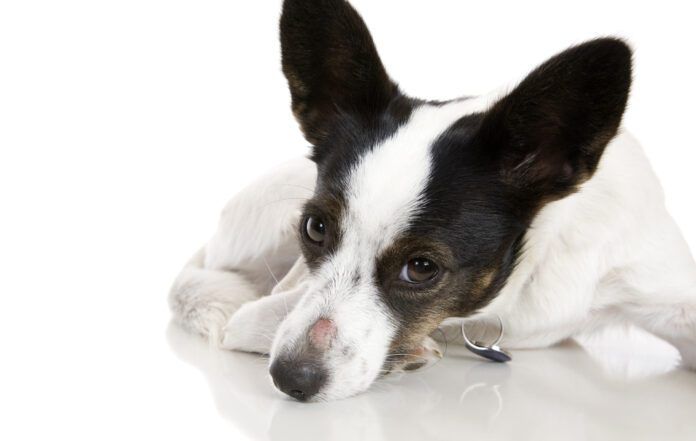
Ringworm on a dog appears as a dry, hairless, circular spot, while a hot spot tends to angry, red, moist lesions that are itchy.
What does ringworm look like on a dog? Ringworm causes small, circular, hairless patches. You may notice scales or crusting, possibly with a red outline on the patches. These tend to be “dry” lesions. While ringworm may be itchy, it is generally a mild pruritus. If it’s itchy, there may be a secondary infection. Note: Ringworm is highly contagious to you and other animals.
What is a hot spot on a dog? Hot spots are usually angry, red, moist lesions. They come on fast and are painful and itchy. Most lesions start out small but grow rapidly as your dog licks and chews. The shape of the lesion is usually irregular. There may be a pus like or yellow serous discharge. Hot spots are often a warm-weather problem.
Ringworm vs. Hot Spots in Dogs
| Ringworm | Hot Spot | |
|---|---|---|
| Cause | Fungal infection | Varies; most common is a bacterial infection |
| Appearance | Dry, scaley, usually circular patches | Angry, red, moist lesions that are painful and itchy |
| Contagious | Yes to other animals and humans | No |
| Common Causes | Contact with another infected animal, bedding, or soil | Fleas, allergies, wet undercoat such as from swimming |
| Treatment | Antifungal medications | Antibacterial cleansing solutions |
Both disease processes may appear on the head and neck, with hot spots often showing up under a dropped ear or on the hip or groin area as well. While ringworm is a primary skin problem, hot spots have an underlying cause such as allergies or flea infestations.
Treatment of Hot Spots in Dogs
Treatment for a hot spot is relatively uncomplicated. Because the lesions are “wet,” you want to dry the area. Start by trimming the hair around the hot spot. Long hairs will delay healing and irritate the sore area. Hot spots are painful, so enlist a helper to restrain your dog and consider the use of a muzzle.
Chlorhexidine is a popular medicinal antibacterial cleaning solution. Clean gently, then dry gently. Your veterinarian may recommend an ointment or a powder (foot powder often works well). If the site was badly infected, antibiotics may be dispensed. A low, tapering dose of a corticosteroid may be prescribed to help with the pruritus (itching).
Pain medications may be dispensed for the first couple of days post diagnosis. It is important to keep your dog from going back and licking and chewing at the hot spot again. An Elizabethan collar may be necessary.
Try to determine the underlying cause, which is likely fleas or allergies. Treat those to prevent recurrence (getting rid of fleas is not easy). However, it may be something as simple as not drying your dog completely after a swim on a hot, humid day.
Treatment of Ringworm in Dogs
Treating ringworm is more complicated due to its contagiousness. You may need to treat all your pets. If you only have the one dog, you can try isolation to contain the fungus.
The hair itself may have fungal spores, so you need to clean and disinfect the house thoroughly. Vacuum and mop daily, taking precautions to keep you ringworm-free as well. All bedding, toys, bowls, and grooming tools need to be frequently and carefully cleaned.
Antifungal baths and topicals may work for a limited infection caught early on, but most dogs will need a prescription for an antifungal medication.
Both these skin infections use require the help of a veterinarian. Delaying the help of your vet with makeshift remedies will make treatment longer and more difficult.
The Best Collapsible Dog Crates
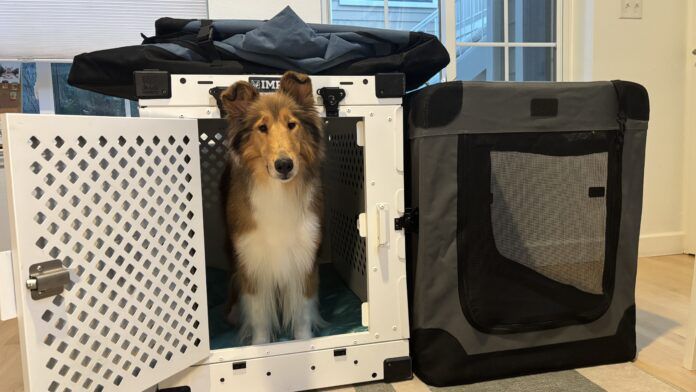
A collapsible dog crate can be a godsend. If you travel with your dog regularly and they’re used to sleeping in a crate at night, having a foldable option you can bring along makes things easier for both you and your pup.
Dog sport enthusiasts will also often use collapsible dog crates at trials for agility, scent work, dock diving, and rally to keep their dog contained (and rested) while they wait for their turn to compete.
Whether you’re going on a trip or taking your dog to do something fun, a collapsible, portable dog crate will give your pup a designated place to rest while you’re on-the-go.
Traits We Want in a Collapsible Dog Crate
Ease of use: A collapsible dog crate should be easy to take down and put up. Ideally, one person should be able to do the setup, take down, and transport of the crate. The best collapsible crates can be assembled in 2-3 minutes or less.
Easy to clean: Collapsible dog crates should also be easy to clean. Since they’ll be traveling with you in most cases, collapsible crates will likely get dirtier than their stationary counterparts that stay in the home, so washable materials are best.
Portability: A collapsible dog crate should fold down to a size that’s easy to get in and out of a car. Bonus points go to crates that have carrying handles or other features that make them easy to transport.
Size range: All sizes of dogs can benefit from collapsible crates, so we gave extra points to options with large size ranges, so you can travel with your Chihuahua or your Great Dane.
Before you pick a collapsible crate for your furry friend, make sure you’ve brushed up on crate training techniques with your dog trainer and have measured your dog to find the right size crate for them.
The Best Collapsible Dog Crates
| Whole Dog Journal Rating | Product and Maker | Price | Sizes | Notes |
|---|---|---|---|---|
   | Midwest Lifestages Double Door Folding Dog Crate | Starting at $39 | 3.5 paws Midwest Lifestages Double Door Folding Dog Crate Starting at $39 22”, 24”, 30”, 36”, 42”, 48” This folding wire crate isn’t perfect, but it’s fairly durable, decently easy to put up and take down, and is budget friendly. While it isn’t the easiest to transport, it’s workable. | This folding wire crate isn’t perfect, but it’s fairly durable, decently easy to put up and take down, and is budget friendly. While it isn’t the easiest to transport, it’s workable. |
   | Impact Collapsible Dog Crate | Starting at $764 | 30”, 34”, 40”, 40”+, 48”, 54” | This crate is incredibly durable and easy to set up and take down, but it’s heavier and more expensive than other options on this list. |
   | EliteField 3 Door Folding Soft Crate | Starting at $55 | 20”, 24”, 30”, 36”, 42” | The EliteField 3 Door crate comes with built-in door covers, so you don’t need to bring an extra sheet or blanket to cover your dog. It’s also washable and comes with a handy carrying bag and a fleece crate pad. |
  | Diggs Revol Dog Crate | Starting at $500 | Small (28.5”), Medium (34.6”), Intermediate (421.2”), Large (45.3”) | Revol Dog Crate folds down and sets up in seconds and has two doors, but it’s heavy, expensive, and has a few other minor quirks that eliminated it from our list of winners. |
   | Orvis Hose-Off Folding Travel Crate | Starting at $160 | Small (31.2”), Medium (36”), Large (42”) | The Orvis Hose-Off crate is quite sturdy as a soft crate and comes with a plush fleece bed. It’s a bit heavier and bulkier than the EliteField option on this list and lacks some of the extra details the EliteField boasts. It’s also pricier. |
Best Collapsible Dog Crate: Midwest Lifestages Double Door Folding Dog Crate
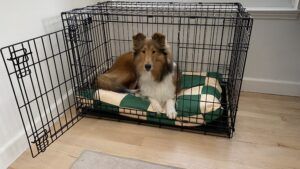
Wire crates can be a pain, but there’s a reason they’re so popular. They’re durable enough to contain most dogs who are properly crate trained, are fairly quick and easy to assemble and disassemble (minus some occasional finger pinching), come in a huge variety of sizes, and are budget-friendly in comparison to other crate options.
The Midwest Lifestages Double Door Folding Dog Crate is one of the most popular dog crates on the market and it held up well during testing. It’s not so lightweight that dogs can easily escape from it, but it’s not so heavyweight that it’s a pain to move around. It folds down to a reasonable size but can be loud in the car due to rattling of the metal.
It has a front door and a side door so you can orient it in different ways and has a pan that can easily be pulled out and cleaned if needed. This crate also has a paw-blocking feature which prevents your dog from tampering with the door latch while they’re inside.
The Midwest Lifestages crate ranges from $39 to $84 depending on the size chosen, so it’s one of the sturdier yet still affordable collapsible dog crate options.
Despite the downsides, a wire crate is the best option for most families and most dogs, given their low cost, size ranges, and decent durability and portability.
Most Durable Collapsible Dog Crate: Impact Collapsible Dog Crate
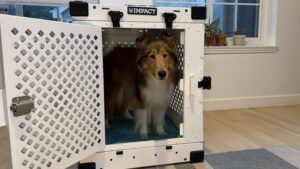
If your dog is sure to escape from (or destroy) a soft-sided or a wire crate, the Impact Collapsible Dog Crate is the way to go. This heavy-duty option is made of high-grade aluminum and is wildly sturdy. It also meets air travel guidelines for pet owners who may need to travel with their dog in the future and comes with a lifetime warranty.
This crate is fairly easy to set up—once you’ve learned to do it properly. The top of the crate, which needs to be unlatched and pulled straight up to assemble, is quite heavy. Those who aren’t strong or mobile may not be able to carry or assemble this crate comfortably by themselves.

When folded, the crate is fairly streamlined, though it’s bulkier and heavier than other crates on this list. It ranges from 28.5 pounds up to 70 pounds depending on the size chosen, so it’s not a lightweight option. However, it does come in a 54” size, making it one of the best large collapsible dog crate options on the market—ideal for owners of XL and giant breeds.
The Impact crate is very secure and even calming for many dogs. I use this crate when I take my Collie to dog shows and because of the more enclosed design, I find that she stays calmer and rests better than if she were in a crate she could fully see out of on all sides (like a wire crate). It features a lock on the front (with matching key), which I use if I’m going to be away from the crate for any period of time.
The biggest downside of this crate, aside from the weight, is the high price. It ranges from $764 up to $2,167, so it’s a huge investment.
Best Collapsible Soft Crate: EliteField 3 Door Folding Soft Crate
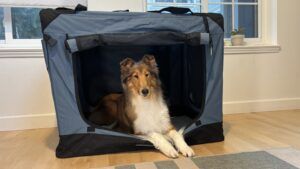
As someone who travels to dog sports events frequently, the EliteField 3 Door Folding Soft Crate is my favorite soft crate option. It’s lightweight, easy to assemble and disassemble, and completely washable. Both the inner bed cover and the crate cover itself can be put in the washing machine for easy cleaning.
My favorite features of this crate are the built-in door covers, which are great for dogs who settle more easily when their crates are covered. This crate also comes with a carrying bag that has a long shoulder strap on it, making it easy to bring along while traveling.
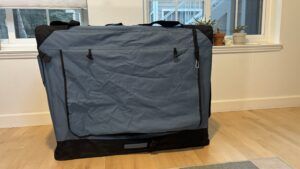
Like most soft crates, this isn’t the most durable crate option and shouldn’t be used for puppies or dogs who chew or escape their crates. Because it’s so lightweight, dogs who move around a lot could also potentially flip it over while they’re inside. A soft crate is best for dogs who are calm and well-acclimated to their crates and who won’t chew on fabric or zippers.
My one qualm about this crate is that the inner fleece bed it comes with isn’t the best quality. My dog tends to dig at bedding while she gets comfortable and the bed this crate came with has already seen some wear and tear from that. I usually bring along a second, more supportive bed to put in this crate, especially when I’m doing extended traveling with my dog.
Other Collapsible Dog Crates We Tested
Diggs Revol Dog Crate
I wanted to love the Diggs Revol Dog Crate. It has a variety of cool, useful features, like wheels for easy transport, wildly quick assembly/disassembly, and a side door that moves up and down garage style.
However, this crate is heavy, bulky, and inconvenient to travel with. When collapsed, there’s nothing that keeps it folded, so it can be a pain to move around. The wheels on the bottom, though a great idea, aren’t always super functional. They’re very small and prone to getting stuck in cracks or on rocks/other debris, and are very loud when used on hard surfaces like concrete or asphalt. The side door could also open/close smoother.
With a price range from $500 to $1,050, I’d expect some of these quirks to be ironed out.
Orvis Hose-Off Folding Travel Crate
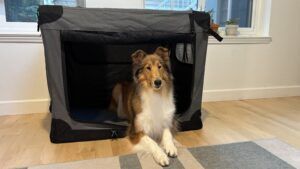
When it comes to soft-sided, collapsible dog crates, the Orvis Hose-Off Folding Travel Crate is sturdier and feels a bit more well-made than the EliteField option, but it’s also bulkier, heavier, and more expensive. Despite having heavier, sturdier poles inside and thicker material, it still won’t contain a dog who wants to get out of a soft crate.
If your dog is well-behaved in a soft crate, the cheaper, lighter EliteField is a better value, and comes with extra features the Orvis model doesn’t have (like a carrying bag and built-in door covers).
Should I Feed a Dog Dental Diet?

Join Whole Dog Journal
Already a member?
Click Here to Sign In | Forgot your password? | Activate Web AccessPigmentary Keratitis in Dogs

Pigmentary keratitis occurs most often in brachycephalic dogs, like Pugs, although it can be seen in other breeds. In simplest terms, pigmentary keratitis is the buildup of melanin or pigment on the surface of the cornea. The pigment will appear brown or black. It can build up enough to block vision.
Unfortunately, the conformation of brachycephalic breeds predisposes them to several health conditions, including ocular ones like pigmentary keratosis. Genetics may also be at work.
What Causes Pigmentary Keratitis in Dogs?
Irritation to the cornea stimulates the pigment deposits. This can be caused by eyelids that roll in, so the eyelashes or hairs rub on the cornea. It can be caused by eyelids that droop, allowing dust and plant material or irritate the cornea. In some cases, irritation is caused by abnormal eye lashes.
Less commonly, direct trauma to the cornea or the rubbing of even benign eyelid tumors may stimulate pigment production. Anything that interferes with blinking or tear production may also lead to corneal damage and pigment production.
The short muzzles of brachycephalic dogs, often with nasal skin folds, mean the hair is closer to the eye. The large, round eyes are open to irritants, including things like blowing dust.
Diagnosing Pigmentary Keratosis in Dogs
Your veterinarian can usually diagnose pigmentary keratosis during a routine office visit, but some vets may suggest referral to a veterinary ophthalmologist for the latest in treatment. Often, a fluorescein stain of the cornea will be done to check for any corneal ulcers that might accompany the pigmentary keratitis as that would mean adjustments in medications.
Can You Treat Pigmentary Keratosis in Dogs?
Many cases of pigmentary keratitis are managed medically. That means eye drops or eye ointments, often multiple times a day. Be sure to follow dosing directions exactly. Immunosuppressive drugs such as cyclosporine or tacrolimus are fairly standard. Artificial tears, as drops or ointments, may be added if your dog also has “dry eye” or a lack of tear production called keratitis sicca.
Along with medical therapy, surgical treatment may be suggested. This surgery is done on the eyelids to correct an eyelid that turns in (entropion) or droops outward (ectropion) or to remove abnormally located eyelashes. Excessive skin folds may be removed. Those corrections would prevent the constant irritation to the cornea. Your veterinarian may perform these surgeries themselves, or they may refer you to a veterinary ophthalmologist.
Preventing Pigmentary Keratitis in a Dog
Can you prevent pigmentary keratitis? Not really. When choosing a puppy, try to pick one with a less extreme “flat” face and search for breeders with more moderate dogs. If your dog has an extreme brachycephalic face, he will be prone to this eye disease.
If you notice any pigment moving onto the cornea, have it evaluated early on before any permanent visual damage is done.
Try to avoid dusty conditions. If you have fans blowing to keep your dog cool, mop or vacuum to reduce dust. Avoid fields during dusty and dry conditions or that have lots of plant material that could irritate the cornea.
Why Does My Dog Lick the Couch?
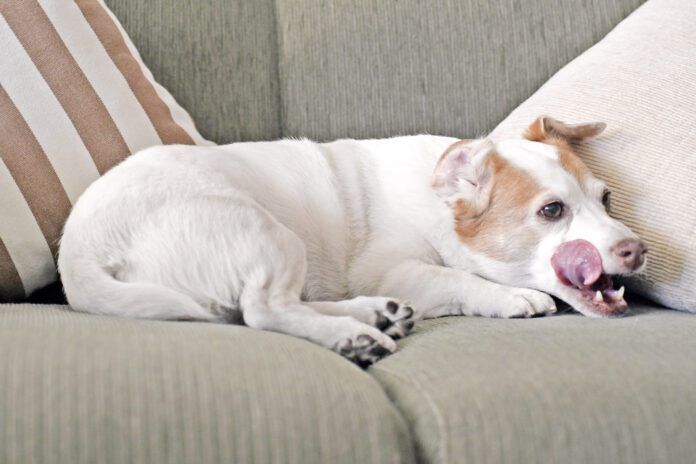
I have often been asked by clients, “Why does my dog lick everything?” Sometimes the reasons are medical and sometimes they’re behavioral. In general, licking everything is normal puppy behavior resulting from exploration and learning about one’s environment. Of course, that does not make it desirable. Redirection rather than correction can prevent licking from becoming obsessive.
Aside from puppy licking, however, one must evaluate the context when determining whether licking the couch or licking the floor is a behavioral or a medical issue. Obviously, if you have a toddler (or a teenager!) and the furniture and the floor are catch basins for your offspring’s snack crumbs, then your dog is an opportunist and licking the floor and the couch for food fragments. That one is easy.
Why Does My Dog Lick Everything?
Insecure dogs often use licking as a signal of “I mean you no harm, please like me.” This is typically directed at the humans in the family, in varying ways. It can be directed toward the face or limbs or other parts of your body, even surfaces that humans are on. Licking behavior can also be directed toward other animal family members, including other dogs and even cats. Grooming the other animal family members can often be a part of that ritual.
Kiss to Dismiss is behavioral but for a different reason than listed above. This lick is a “go away” lick. It’s meant to create space between the dog performing the lick and the object of his licking. This can be directed at visitors, children in the family, even other animal family members. This is why context is important in determining the reason a dog is licking. (Dog behavior expert Jennifer Shyrock is responsible for coining the term “Kiss to Dismiss.”)
Other behavior-focused licking reasons include:
- Boredom
- Attention seeking
- Anxiety and stress
- Obsessive compulsive disorder (OCD)
If you suspect your dog is licking due to odd behavior, consultation with a veterinary behaviorist or a trainer with a certification in behavior is indicated.
Medical Reasons Your Dog May Lick the Floor and More
One of the most common medical causes of unusual surface licking in dogs is canine cognitive disorder, also known as doggy dementia. This symptom can be especially prevalent in the evening. Other possibilities include:
- Pain is a common reason for your dog licking, including licking himself or his lips.
- Gastrointestinal issues are one of the biggest causes of this issue. If the licking is sudden and urgent seeming, an immediate trip to a veterinarian is in order.
- Nutritional deficiencies have been theorized to cause licking.
- Dental pain as licking may be an attempt to self-sooth.
- Neurological issues are also a potential cause. Context is important here as well.
- Adrenal conditions like Cushing’s disease can cause odd licking behavior in dogs. Keeping a log of the context can assist your veterinarian with solving this puzzle.
First rule out medical causes with your veterinarian. Once medically cleared, you can consider meeting with a qualified behavioral consultant to help you with a plan to address the unusual licking behavior.
In addition to making sure that your dog is getting adequate physical and mental enrichment, the behavior plan should include how to properly redirect your dog’s attention while teaching them coping skills and better self-soothing options.
Natural Tick Repellents for Dogs
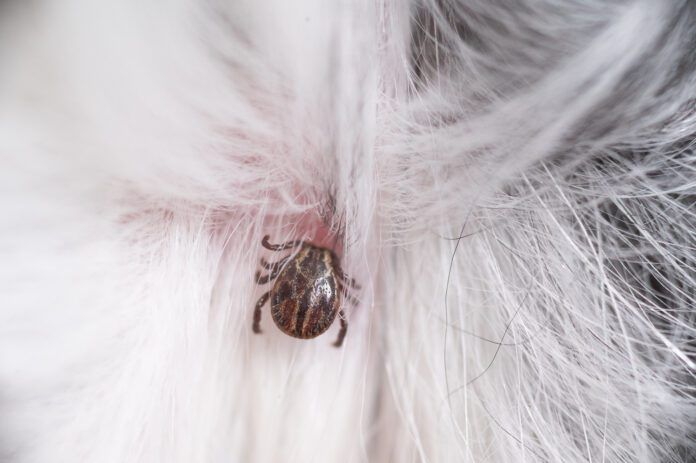
Join Whole Dog Journal
Already a member?
Click Here to Sign In | Forgot your password? | Activate Web AccessVet-Recommended Dog Chews
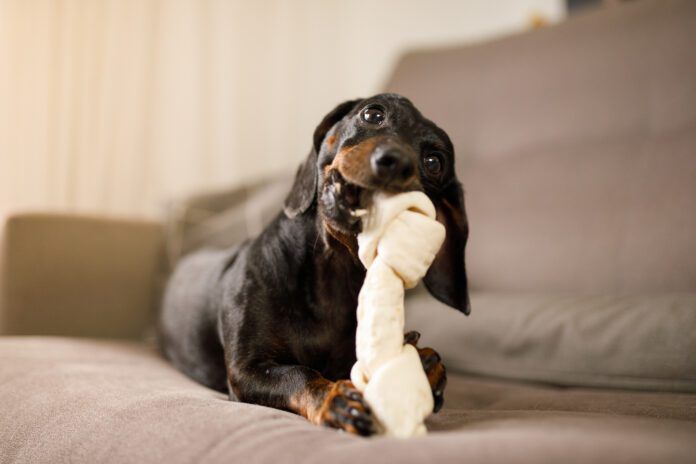
Dog chews have real benefits. They can help with dental health, help alleviate anxiety, and provide mental stimulation. And, most dogs just love to chew.
“Chewing is your canine friend’s equivalent to scrolling through social media posts when you want to kill a few extra minutes,” according to American Animal Hospital Association (AAHA). “Bored dogs are often naughty—barking excessively, digging, and destroying your belongings—so encouraging appropriate chewing is important.”
Of course, as with any consumer product, navigating the wide array of options can be overwhelming. This article will help you make informed choices, ensuring your dog’s safety and well-being, including dental chews, anxiety-reducing chews, and allergy chews. (Also, check out Whole Dog Journal’s test of seven popular chews.)
Whole Dog Journal is reader-supported. If you purchase through links on our site we may earn a commission. Whole Dog Journal does not accept money for its food and product reviews.
Vet-Recommended Dog Dental Chews
Veterinary professionals and organizations like the American Veterinary Medical Association (AVMA) and the AAHA recommended products accepted by the Veterinary Oral Health Council (VOHC) when choosing a dog dental chew.
Dental disease is one of the most common health problems in dogs. It can lead to pain, infection, and even health issues affecting the heart, kidneys, and liver. While daily tooth brushing is most effective for at-home care, supplementary dental chews, which can help scrape away plaque and reduce tartar buildup are a valuable addition to your dog’s oral hygiene routine.
The VOHC seal is an independent indicator that a product has undergone scientific testing and is proven to reduce plaque and/or tartar. In short, a VOHC seal on a dental chew means a team of experts verified that the product is safe and effective.
Popular VOHC-accepted options include:
Greenies: Greenies have multiple products and sizes.
Earned the VOHC seal for helping to control both plaque and tartar.
WHIMZEES: This brand of vegetarian dental chew is well-known for their unique shapes.
Earned the VOHC seal for effectiveness in reducing plaque and tartar.
OraVet Dental Hygiene Chews: These chews are formulated to create a barrier to help prevent bacteria from attaching to a dog’s teeth.
Earned the VOHC seal for tartar control.
C.E.T. VeggieDent Chews: Virbac offers plant-based chews.
Earned the VOHC seal for helping to control plaque and tartar.
Purina DentaLife: A popular, consumer-friendly brand daily oral care treats.
Earned the VOHC seal for helping to control tartar.
Milk-Bone Brushing Chews: Known for ridged texture designed to scrub teeth as the dog.
Earned the VOHC seal for tartar control.
Pedigree Dentastix: This brand is widely available.
Earned the VOHC seal for helping to control tartar.
The VOHC’s official list is extensive and includes many product types, flavors, and sizes.
In addition to VOHC seal of acceptance look for ingredients like chlorophyll, enzymes, and zinc gluconate, which can further aid in oral health. While dental chews are beneficial, they are not a substitute for regular professional dental cleanings by your veterinarian.
For other types of chews, veterinarians recommend a nuanced approach to other chew types:
Dog Calming Chews: Easing Anxiety Naturally
If your dog suffers anxiety due to separation, thunderstorms, travel, or other triggers, calming chews can offer a solution. Many chews use natural ingredients like L-tryptophan, chamomile, passionflower, or hemp-derived compounds (such as CBD, where legal), even, according to some research reports, melatonin.
These ingredients work to promote relaxation. When selecting a calming chew, look for products with third-party testing to ensure purity and accurate dosing. Your vet can advise on the appropriate type and dosage for your dog’s specific anxiety level.
According to a Cornell DogWatch article, 83% of dogs given CBD chews prior to a stressful event showed a decrease in stress or anxiety-related behaviors. However, Cornell DogWatch warns that more research with different CBD products and dosages is needed. For that reason, it’s especially important to consult with your veterinarian about CBD chews.
No-Hide Chews: A Safer Alternative to Rawhide
Rawhide chews have been proven to bring significant risks, including choking, digestive upset, and intestinal blockages. “Rawhide is difficult to digest due to it being a byproduct of leather, making it difficult for a dog’s digestive system to break down. This creates a risk of obstruction in the esophagus or intestines if a dog swallows a large piece,” according to the Preventivevet.
A Cornell report concurs, adding that in addition to rawhide, “Chewing hard objects can result in either gradually wearing or fracturing of teeth. Use caution when offering your dog any hard objects including bones, antlers, hooves, and hard manufactured toys.” As a rule of thumb, if you can bend or flex the object, it is less likely to fracture a tooth. Additionally, if something is too hard for you to chew, then you should not allow your pet to chew it.
No-hide chews are a safer alternative and are typically made from digestible proteins like chicken, beef, or pork. They are designed to break down more easily in a dog’s digestive system, reducing the risk of obstruction.
Dog Allergy Chews: Soothing Itchy Skin and More
Symptoms of allergies in dogs include itchy skin, paw licking, ear infections, or digestive issues. Allergy chews often contain ingredients aimed at supporting skin health and immune function. Common ingredients include omega-3 fatty acids, quercetin (a natural antihistamine), spirulina, and probiotics. These ingredients work to reduce inflammation, strengthen the skin barrier, and regulate the immune response. If your dog is experiencing allergy symptoms, your first step is to contact your veterinarian to diagnose and treat specific allergens and develop a plan, which may include chews.
Vet-Recommended Options for Aggressive Chewers
Some dogs make short work out of chews that may be marketed as long-lasting. Aggressive chewers require durable, safe chews that can withstand their powerful jaws without splintering or posing a choking hazard. Also, long-lasting chews provide mental stimulation and keep energetic dogs occupied. For these dogs, vet-recommended options often include:
- Rubber toys: Brands like Kong offer durable rubber toys that can be stuffed with treats, providing a long-lasting challenge without the risk of splintering.
- Hard cheese chews: Made from yak and cow milk, these chews are hard and long-lasting, gradually softening as your dog chews them.
- Nylon or polymer chews: Tough, nontoxic synthetic chews are designed to withstand aggressive chewing and are specifically designed for this purpose.
Something to Chew On
Choosing the right chew for your dog involves careful consideration of your dog’s individual needs, chewing style, age, and any health concerns. One dog might take a long time to chew through the same chew that another dog gnaws slowly. Never leave your dog unattended when he’s chewing on anything; there is always a risk of choking.
Overall, by prioritizing general vet-recommended products, talking with your own veterinarian, and doing your research on the benefits and risks of different types of chews, you can provide your canine companion with safe, enjoyable, and beneficial chewing experiences.
Coccidia in Dogs
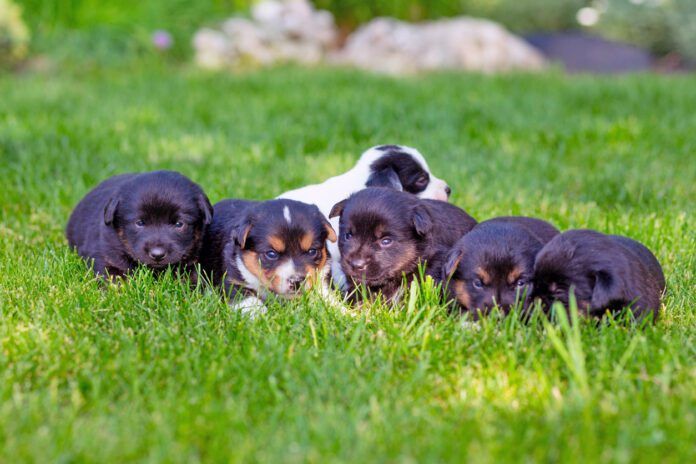
Coccidia are common intestinal parasites that impact dogs, particularly puppies and immunocompromised animals. While this may sound alarming, coccidiosis in dogs, the disease caused by the coccidia parasite, is treatable and preventable with proper hygiene and prompt veterinary care.
What Are Coccidia in Dogs?
Coccidia are microscopic, single-celled organisms known as protozoa. They infect the intestinal lining of dogs and reproduce within the cells of the intestinal tract. Unlike some parasites, coccidia cannot be seen with the naked eye and require microscopic examination of a fecal sample for proper diagnosis.
How Did My Dog Get Coccidia?
Dogs, especially puppies, typically become infected with coccidia by ingesting oocysts, the parasite’s hardy eggs, which are shed in the feces of an infected animal. These oocytes can survive in the environment for extended periods of time, particularly in warm, moist conditions like kennels, dog parks, or the soil in yards.
A dog may ingest the oocytes by licking contaminated surfaces, eating contaminated food or soil, or having contact with infected feces. Once ingested, the oocysts go under changes that allow the organism to invade the cells of the dog’s intestinal lining, leading to inflammation and gastrointestinal upset.
Coccidiosis is most common in puppies under 6 months of age because their immune systems are still developing and are less able to fight off infection. Stress, such as weaning or relocation, can further weaken a puppy’s immune system and make them even more vulnerable to infection.
Adult dogs can also become infected, although they may not show signs of infection and can act as asymptomatic carriers, shedding and spreading the parasite to more vulnerable animals.
What Does Coccidia Cause in Dogs?
The symptoms of coccidiosis can vary based upon the dog’s age, immune status, and the severity of infection. In mild cases, there may be no visible symptoms. More commonly, infected dogs may experience:
- Watery or diarrhea, with mucous and/or blood
- Dehydration
- Vomiting
- Weight loss
- Lethargy
- Pot-bellied appearance
Left untreated, especially in puppies or dogs with underlying health issues, coccidiosis can lead to severe dehydration which can be life-threatening if left untreated.
Diagnosis is made by a veterinarian through a fecal flotation test, where the stool sample is examined under a microscope for the presence of oocysts.
Treatment for Coccidia in Dogs
Treatment involves prescription antiparasitic medications that help stop the parasite from reproducing. Treatment may last five to 14 days, depending on the severity of infection. In severe cases, supportive care such as fluids, electrolytes, and a diet for sensitive stomachs may be needed to help stabilize the dog.
If your dog tests positive for coccidia, sanitation is key. Avoid visiting high-traffic areas, like dog parks and kennels, with puppies or young dogs. Remove any feces from your yard and bag it for disposal. Wash toys and bedding and keep the areas your dog frequents sanitized. While there is no vaccine for coccidia, good sanitation, stress reduction, and early intervention can go a long way in controlling its spread.
Preventing Coccidia Infections in Dogs
Coccidia spreads easily though contaminated feces and the environment, but with early detection and appropriate treatment, most dogs recover quickly. Responsible pet care, including routine vet visits, fecal screenings, and maintaining sanitary conditions can help prevent infection and keep your dog happy and healthy.
What Can I Wash My Dog With (That Isn’t Dog Shampoo)?
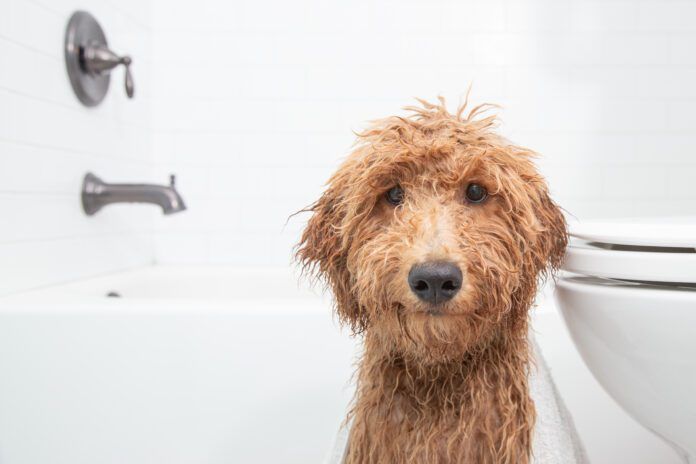
Some dogs have a knack for rolling in disgusting, decaying, and dreaded guck. It usually happens when the pet supply shops and the groomer are closed and that bottle of dog shampoo you had in your cabinet is nearly empty.
You scratch your head and think, “What can I wash my dog with that isn’t dog shampoo?”
You start frantically rummaging through your house, looking for anything that might be a dog shampoo alternative, mumbling to yourself, “Hmmm, is Dawn dish soap safe for dogs? Is baby shampoo safe for dogs? Wait, can you use human shampoo on dogs?”
We surveyed the experts, and while you shouldn’t make a habit of it, you can use some of these products to wash your dog in case of a malodorous emergency. However, there are some caveats.
Here’s why: Human shampoo is formulated for humans. Dog shampoo is made for dogs. When you use a non-dog shampoo on your pooch, it could cause irritation, dandruff, or even skin ulcers that need medical attention.
“Dog skin is not as thick as human skin,” says veterinarian Mitzi Clark, an assistant clinical professor of dermatology at Cornell University College of Veterinary Medicine. “The outer layer of the skin is thinner in dogs, so it’s much easier to strip that outer layer of a dog’s skin and dry it out.”
And anything you use on a dog’s skin seeps into their system faster than it would in a human.
“It’s easier to penetrate the outer layer of a dog’s skin, the epidermis, and get to the dermis, which is the layer of skin that has the blood vessels where the ingredients could be absorbed into their system,” Dr. Clark says. “Dogs, in general, due to having thinner skin, just don’t have as much protection against the world as other species, including humans. It’s one of the reasons they probably have more issues with bacterial infections, allergies, and other diseases that predispose their skin to those conditions.”
So knowing dogs generally have more sensitive skin than humans, how should you answer the question: What can I wash my dog with that’s not dog shampoo? Here’s what you need to know.
Is Dawn Dish Soap Safe for Dogs?
Dawn dish soap is well known in animal rescue circles for working miracles. Rescuers use it to de-grease wild animals soaked in oil after spills and help dogs and cats covered in fleas and ticks. It’s also the main ingredient in a DIY skunk smell-removing shampoo.
“It’s a really potent degreaser, that’s why we use it to degrease our dishes,” Dr. Clark says. “It’s very stripping to a dog’s outer layer of skin, so the biggest issue is that it can be drying.”
But if you have a doggone disaster, Dawn dish soap is typically safe for dogs.
“It wouldn’t be something we would recommend doing weekly, or on an ongoing basis, or for a long time,” Dr. Clark says. “But if you have a situation where, ‘My dog just rolled on a dead animal,’ it’s something you could reach for in a pinch, and most animals are going to tolerate it fine.”
Avoid getting dish soap in your dog’s mouth, eyes, and ears. Their ear canals are more sensitive than their skin.
“Dilute the dish soap in some water first, so you can get more mileage out of it, rather than just slapping it on one section of the dog,” says extension veterinarian Aly Cohen from the Cornell University College of Veterinary Medicine. “Be sure to really, really rinse your dog thoroughly so you don’t have any leftover residue in the fur or the skin that could sit there and cause some irritation.”
Can You Use Human Shampoo on Dogs?
If you have a favorite shampoo that makes your hair glossy, shiny, and silky, that’s likely because it’s designed for humans. It might not do the same for your dog. Before you consider using human shampoo on dogs, check the ingredients.
“Some of the more natural products that contain essential oils can be a problem,” Dr. Clark says. “We’ve seen reactions to tea tree oil, citrus oil, and citronella oil. You have to be careful using shampoos with essential oils on dogs. Some of them can be quite harmful; those are things I would steer away from.”
Our experts also recommend steering clear of using human shampoos that contain parabens, phthalates, and formaldehyde on dogs.
“I would try to avoid anything that’s heavily fragranced with perfumes or extra scents,” Dr. Cohen says. “Those can be a little harsh, irritating, or sometimes even toxic, if they happen to ingest any of it.”
Can You Use Baby Shampoo on Dogs?
Is baby shampoo safe for dogs? You may think, “If it’s gentle enough to use on a baby, it must be OK for dogs, right?” Not necessarily.
“Baby shampoo will generally be a little bit milder than regular human shampoo,” Dr. Cohen says. “But they’re generally still formulated for human skin.”
Make sure the baby shampoo doesn’t contain any of the ingredients that can be harmful to dogs, which are sometimes found in human shampoos.
Before you dive into your cabinet looking for dog shampoo alternatives, remember that if your dog is covered in something that’s not oily, greasy, or smelly, you can just use water to rinse them off; no shampoo is needed. Unless dogs have a medical condition and need special shampoo and baths, they don’t typically need to be bathed regularly.
While not ideal, turning to dish soap, human shampoo, or baby shampoo when you have a putrid predicament may be the stink-reducing rescue potion you need; with the proper precautions, these products could work as dog shampoo substitutes. You may also be able to make your own dog shampoo from ingredients you have on hand.
Keep in mind that there’s no guarantee your dog won’t have a problem or reaction to any of these alternatives, even if you use shampoo made for dogs. Every dog and product is different.
“After using a new shampoo, keep an eye on them,” Dr. Clark says. “If they’re a little bit flaky, but the dog doesn’t care, fine. If they get red and irritated, they may need veterinary care. I think probably the most important takeaway is that even though dogs are family members, pet parents need to understand that their skin is different. Not everything safe for humans is necessarily safe for dogs.”
Understanding Dog Temperament
